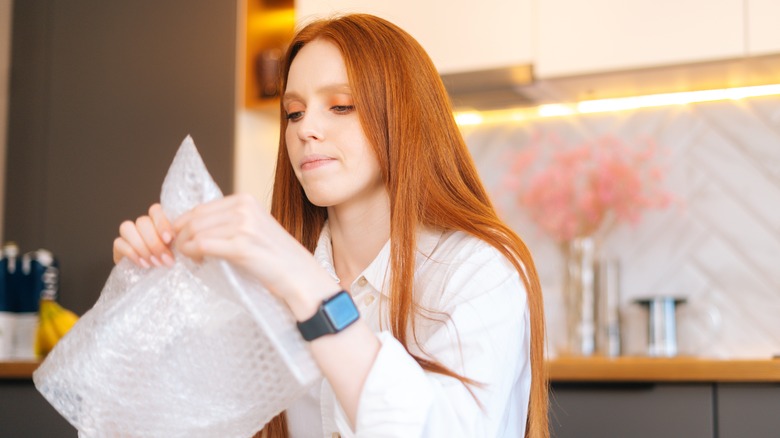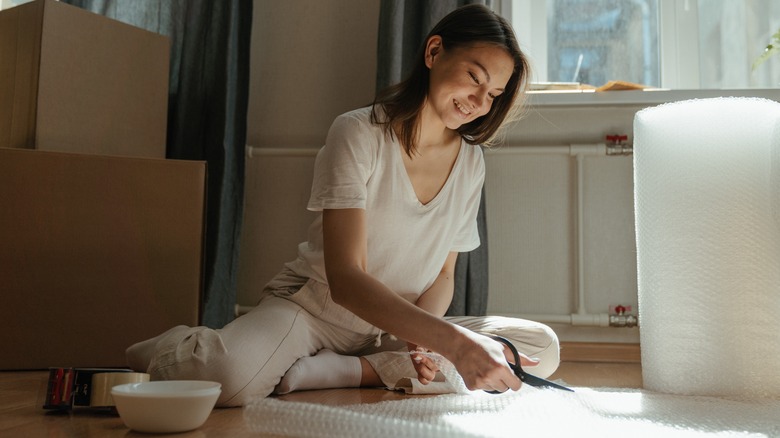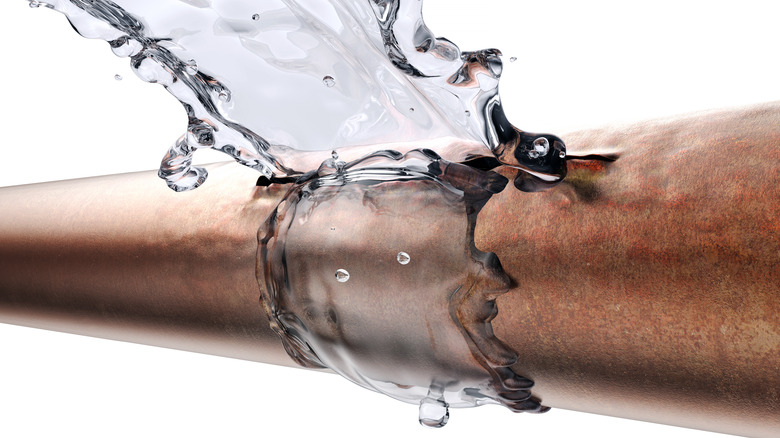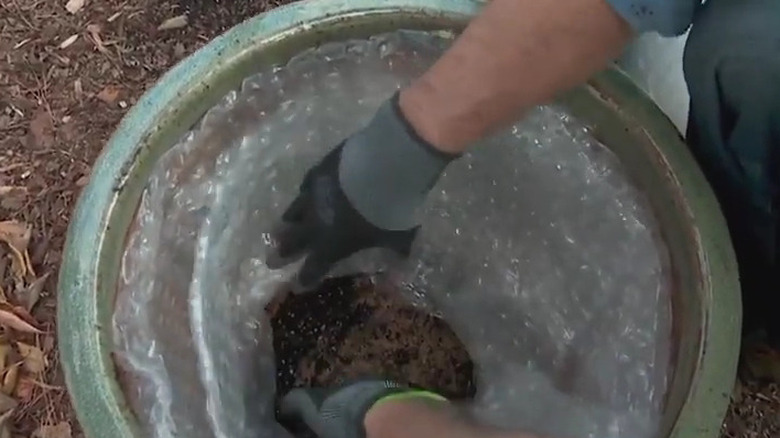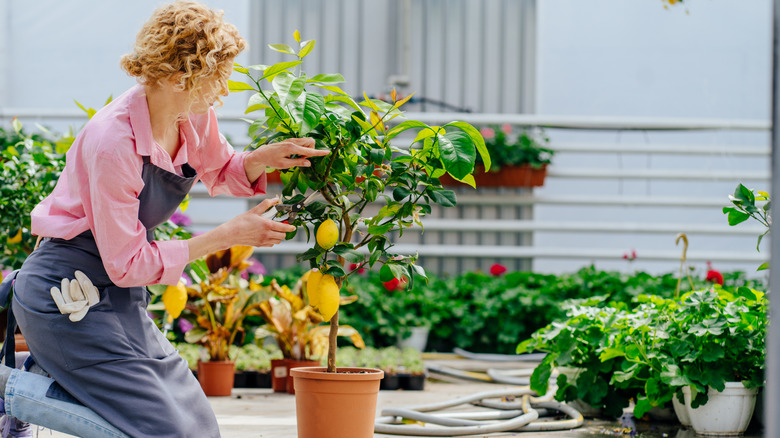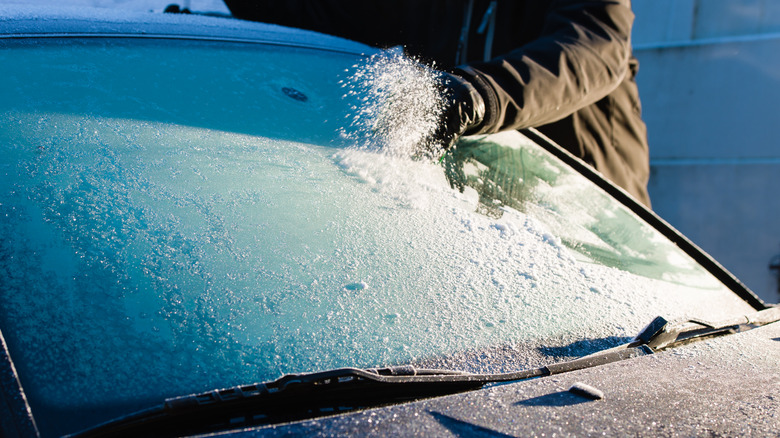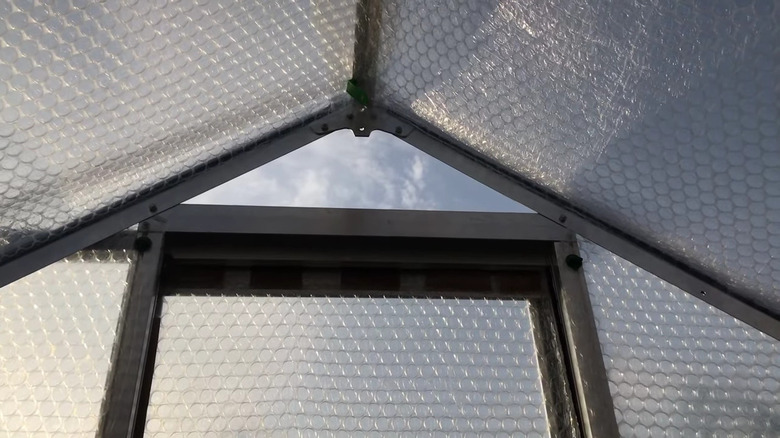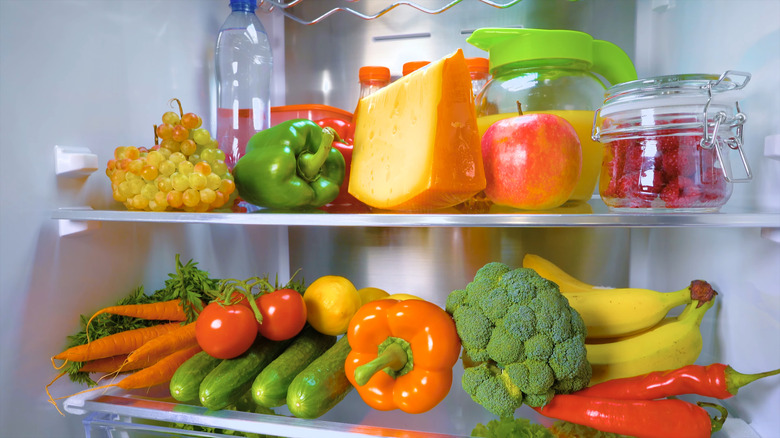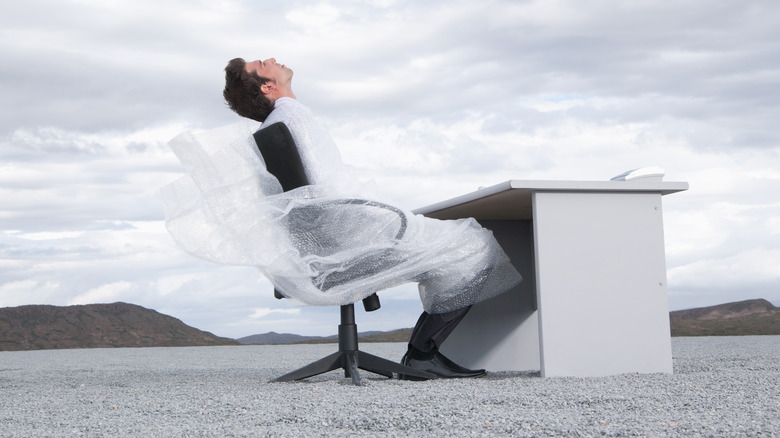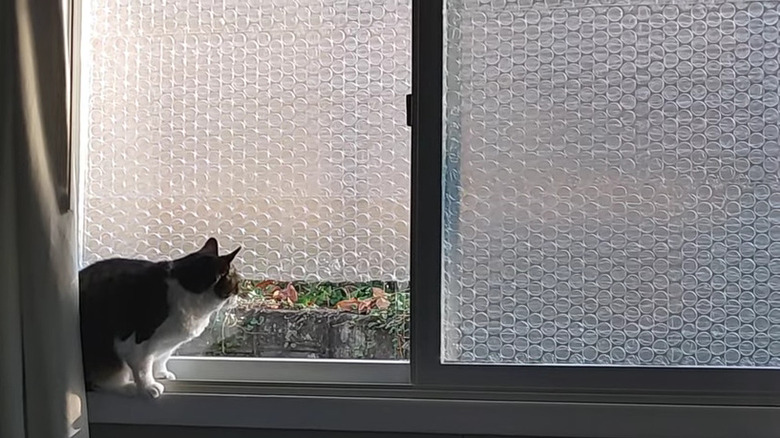Genius Ways Bubble Wrap Can Improve Your Home And Garden
Bubble wrap is one of life's perfect little pleasures. The warm and strangely satisfying glow that popping the little plastic bubbles entails defies reason or rhyme. Once you pop, you can't stop and it takes a disciplined child or adult to refrain from immediately cutting loose at the first sight of bubble wrap.
As with all the fundamentally great things in life, bubble wrap is capable of so much more than packaging parcels or relieving stress. When you scratch the surface of bubble wrap you'll find it's a superhero disguised as a household item. It's time to forget what you know or think you know about bubble wrap. Let's take a deep dive into all the ways bubble wrap can be used around the home and garden for the greater good. Whether you're a gardener or a DIYer, there's likely a way bubble wrap can make your job easier.
Why bubble wrap was originally invented
It's tempting to believe bubble wrap was handed down to us mere mortals from some benevolent god sitting on Mount Olympus. Yet its origins are rather less remarkable. The story begins in 1957 when Alfred Fielding and Marc Chavannes put their heads together and created 3D wallpaper. The two engineers soon discovered that their product, which involved trapping air bubbles between shower curtains, was never going to catch on. As any self-respecting entrepreneur does in the face of overwhelming public indifference, they switched tactics. What was once textured wallpaper was now marketed as greenhouse insulation. Once again this failed to prove a hit with the American public.
Three years later and some bright spark at Sealed Air discovered that Fielding and Chavannes's product was ideal for wrapping IBM computers in during transit. Realizing its protective potential for its precious machines, IBM struck a deal and the rest is history. Bubble wrap has since become synonymous with shipping and storing goods. There is now even a bubble wrap appreciation day held on the last Monday of January. It is estimated that each year enough bubble wrap is produced to bridge the distance from the Earth to the Moon. Cosmic!
Use bubble wrap to prevent pipes from bursting
Burst pipes are a nightmare no one wants to wake up to. They are expensive to fix and the flood damage to your home can be extensive. The most common cause for a burst pipe is plummeting temperatures. When water freezes it expands and can cause undue stress and strain on your pipes, causing them to burst. When the water thaws the pipes will leak and cause untold misery. Prevention is always the best cure when it comes to burst pipes and it doesn't have to be costly. Particularly if you use bubble wrap.
Identify the pipes you wish to protect from freezing, such as those that are located in exterior and unheated spaces. Before you wrap your pipes in bubble wrap, give them a good clean and wipe away all grease and dirt. Ensure they are bone dry before applying the bubble wrap. Any moisture can weaken the grip of the insulating material. Wrap the entire length of the pipe with bubble wrap in spiral loops and seal tightly at both ends with duct tape. The trick is to not leave any area exposed. Once you've insulated with bubble wrap you can rest easy all winter long knowing your pipes are protected.
Frostproof your plants with it
Pipes aren't the only things to suffer in the cruel chill of winter. When the snowflakes storm and the frost cuts to the bone, many plants also tend to wither up and die. Potted plants, fragile perennials, and specimen trees are all vulnerable to the bitter winds, lashing rain, and minus-zero temperatures of the bleak midwinter. Cold conditions can freeze the water in the cells of your plant. To ensure your garden survives the barren months in one piece, it's wise to frostproof your plants with bubble wrap.
Plant doctor Richard Cheshire told Country Living, "Just like us, our outdoor plants can get upset by the continuous change in weather conditions. Whilst some will resist, most need to be prepped for the somewhat extreme weather they may have to face." To stop Jack Frost from creeping in and rotting the roots of your plants, protect the pots with a healthy layer of bubble wrap. The insulation it provides will act like a mini greenhouse and keep them warm enough to survive the harshest conditions.
Bubble wrap can make gardening less taxing on your knees
There's no doubt about it, gardening is good for the soul. All the sowing, mowing, and growing rewards us with a better understanding of the cycle of life. Yet award-winning roses and the sort of geraniums that keep your neighbors awake at night with envy come at a cost. Being a son of the soil or daughter of the dandelions is hard work. All that repetitive digging, lifting, planting, pruning, bending, and kneeling that gardening involves is taxing on your muscles and joints – particularly the knees.
Gardener or housemaid's knees is a very real condition. If you spend an inordinate amount of time kneeling, the prepatellar bursa at the front of your knee is at risk of becoming inflamed. This makes it difficult to walk let alone kneel. Although warm-up exercises and frequently shifting positions can help, if you're kneeling when you're gardening, you should invest in something to support your knees. Bubble wrap makes a perfect and inexpensive knee pad. Fold some sheets to make a durable and sturdy rectangle support and place it on the ground. You'll soon find life on your knees can be surprisingly comfortable.
Use it as a makeshift protector for your car's windshield
Waking up in the winter is a certified drag. Leaving the warmth and refuge of the duvet to face another bleak midwinter morning is harrowing enough. Yet, finding your car windshield is also frozen over is enough to push even the most restrained soul over the edge. The good news is that an icy windshield is an avoidable headache, especially if you have a roll of bubble wrap handy.
Bubble wrap's insulating properties are legendary. Their densely packed air pockets are great at regulating temperature. Completely cover your car's windshield overnight with a piece of bubble wrap and its insulation properties will keep the cold out and ice off. There'll be no tiresome or weary scraping in the morning. No freezing hands and endless cussing. Simply remove the bubble wrap with a flourish, wave merrily to the neighbors, effortlessly fire up the ignition, and you're good to go.
It'll keep your groceries cool
Bubble wrap isn't just good at keeping the cold out it is also adept at keeping the cold in. Next time you take a trip to the grocery store in the fierce heat of the midday summer sun, why not try lining your grocery bags with bubble wrap? The air pockets will prevent the warm air from spoiling your strawberries and curdling your cream. If you're familiar with the insulated grocery bags you can order online, this is the same general idea – just much less expensive, and it can help you reuse any bubble wrap you may have lying around.
It's a good idea to take a few extra sheets of bubble wrap to the store with you in case you need to prevent items from defrosting, such as ice cream and your bumper bag of economy burgers. Wrap them in bubble wrap before placing them in your bubble wrap-lined bag and no one's ruining your party. This hack always works well to keep those ice-cold cans of sodas and beer extra refreshing and chilled. After all, who wants a room-temperature beverage in summer?
Bubble wrap your greenhouse for extra heat
There's nothing like walking into a greenhouse as a kid. The humidity, smell of tomatoes, and abundance of foliage conspire to make a big impression. In the spring and summer, greenhouses are also great places to kick back in idle repose and ponder Plato's Theory of Forms. However, in the winter, when the north wind blows and all that grows shrivels and dies, greenhouses can turn into soulless and dispiriting shacks. Here's where bubble wrap can help.
By covering your greenhouse in bubble wrap, you're adding an extra layer of insulation. This is perfect for when the sun doesn't shine and the greenhouse is unable to absorb its energizing and nourishing heat. Additionally, by preventing any existing heat from escaping, you're creating an optimal environment for growing winter produce. Lettuce, potatoes, cabbage, broccoli, brussel sprouts, spinach, and kale can all be grown during the winter months.
Bubble wrap can help keep your fridge clean
Your refrigerator crisper drawer might be great for storing your fruit and veg and keeping them crisp. However, it's not so great at stopping them from rolling around and banging into one another when you open and close the drawer.
Peaches bruise easily, but that's the least of your problems. When items in the fridge rot, they can leave behind sticky stains that are a hassle to clean. Yet there is a solution and it's called bubble wrap. Cut the bubble wrap to fit your drawer. Sticking it in place is not necessary because the weight of your accumulated groceries should hold it in place. And presto! The bubble wrap should help cement your produce in position and stop it from rolling about when you open and close the drawer. However, the greatest benefit is that the bubble wrap will effortlessly absorb all the spills and stains that threaten to ruin the immaculate cleanliness of your fridge. And when the bubble wrap has done its job, simply take it out and replace it with another sheet.
Use bubble wrap to make that uncomfortable chair a little more relaxing
For those who tend to sit a lot, a comfortable chair takes on universal importance. You cannot underestimate the life-enhancing qualities of a chair you sink into as opposed to one that appears to actively dislike every bone and nerve-ending in your body. If you have a non-ergonomic chair that isn't all that comfortable or supportive, don't ditch it just yet; grab the bubble wrap and get creative.
A good ergonomic chair will have lumbar support built into it. It supports the curved area of your spine and prevents your muscles from tightening and getting sore after hours of sitting at your computer. Regular office and dining room chairs lack lumbar support, but you can make your own with some bubble wrap. Take a healthy amount of bubble wrap and roll it into a cylinder shape. Place it on your chair and position the wedge to maximize your benefit and comfort. You may want to play around with the thickness and shape of the bubble wrap wedge. When it suits your specific needs, tape it firmly into place and you should have a chair that'll be fit for a king or queen.
Bubble wrap is an inexpensive window insulator
Windows are great for spying on the neighbors and gazing into the indifferent skies as you compose existential poetry. However, at times windows aren't so great at keeping in the warmth when winter comes calling. This is bad for your naturally sunny disposition and the size of your energy bills. Bubble wrap is cheap but it can work as a highly-effective insulator for your windows. Because bubble wrap is made of trapped air and plastic, it effectively holds onto heat instead of allowing it to drift from one place to another.
To insulate your windows with bubble wrap, measure the size of the area you intend to cover and cut the bubble wrap accordingly. It's best to use bubble wrap with medium size bubbles. Spray a little water on the window, attach the bubble wrap by the smooth side, and hold it in place until you are sure it is properly attached to the window. You now have a cost-effective and practical insulator that will not prevent the light from coming through, and you also won't have to worry about it damaging or staining your window. When winter ends you can remove the bubble wrap and treat yourself to something nice with all the money you have saved on your energy bills. Who knows, you may wish to celebrate by having a little bubble wrap party. Happy popping!
